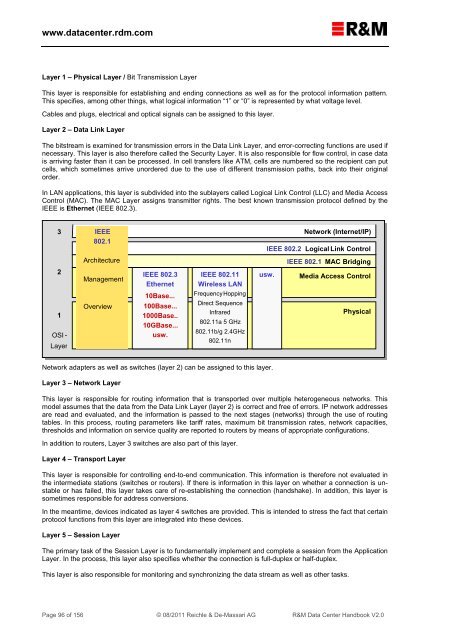R&M Data Center Handbook
R&M Data Center Handbook
R&M Data Center Handbook
Create successful ePaper yourself
Turn your PDF publications into a flip-book with our unique Google optimized e-Paper software.
www.datacenter.rdm.com<br />
Layer 1 – Physical Layer / Bit Transmission Layer<br />
This layer is responsible for establishing and ending connections as well as for the protocol information pattern.<br />
This specifies, among other things, what logical information “1” or “0” is represented by what voltage level.<br />
Cables and plugs, electrical and optical signals can be assigned to this layer.<br />
Layer 2 – <strong>Data</strong> Link Layer<br />
The bitstream is examined for transmission errors in the <strong>Data</strong> Link Layer, and error-correcting functions are used if<br />
necessary. This layer is also therefore called the Security Layer. It is also responsible for flow control, in case data<br />
is arriving faster than it can be processed. In cell transfers like ATM, cells are numbered so the recipient can put<br />
cells, which sometimes arrive unordered due to the use of different transmission paths, back into their original<br />
order.<br />
In LAN applications, this layer is subdivided into the sublayers called Logical Link Control (LLC) and Media Access<br />
Control (MAC). The MAC Layer assigns transmitter rights. The best known transmission protocol defined by the<br />
IEEE is Ethernet (IEEE 802.3).<br />
3<br />
IEEE<br />
802.1<br />
Network (Internet/IP)<br />
IEEE 802.2 Logical Link Control<br />
2<br />
1<br />
OSI -<br />
Layer<br />
Architecture Übersicht<br />
Management<br />
Architektur<br />
Management<br />
Overview<br />
IEEE 802.3<br />
Ethernet<br />
10Base...<br />
100Base...<br />
1000Base..<br />
10GBase...<br />
usw.<br />
IEEE 802.11<br />
Wireless LAN<br />
FrequencyHopping<br />
Direct Sequence<br />
Infrared<br />
802.11a 5 GHz<br />
802.11b/g 2.4GHz<br />
802.11n<br />
usw.<br />
IEEE 802.1 MAC Bridging<br />
Media Access Control<br />
Physical<br />
Network adapters as well as switches (layer 2) can be assigned to this layer.<br />
Layer 3 – Network Layer<br />
This layer is responsible for routing information that is transported over multiple heterogeneous networks. This<br />
model assumes that the data from the <strong>Data</strong> Link Layer (layer 2) is correct and free of errors. IP network addresses<br />
are read and evaluated, and the information is passed to the next stages (networks) through the use of routing<br />
tables. In this process, routing parameters like tariff rates, maximum bit transmission rates, network capacities,<br />
thresholds and information on service quality are reported to routers by means of appropriate configurations.<br />
In addition to routers, Layer 3 switches are also part of this layer.<br />
Layer 4 – Transport Layer<br />
This layer is responsible for controlling end-to-end communication. This information is therefore not evaluated in<br />
the intermediate stations (switches or routers). If there is information in this layer on whether a connection is unstable<br />
or has failed, this layer takes care of re-establishing the connection (handshake). In addition, this layer is<br />
sometimes responsible for address conversions.<br />
In the meantime, devices indicated as layer 4 switches are provided. This is intended to stress the fact that certain<br />
protocol functions from this layer are integrated into these devices.<br />
Layer 5 – Session Layer<br />
The primary task of the Session Layer is to fundamentally implement and complete a session from the Application<br />
Layer. In the process, this layer also specifies whether the connection is full-duplex or half-duplex.<br />
This layer is also responsible for monitoring and synchronizing the data stream as well as other tasks.<br />
Page 96 of 156 © 08/2011 Reichle & De-Massari AG R&M <strong>Data</strong> <strong>Center</strong> <strong>Handbook</strong> V2.0


